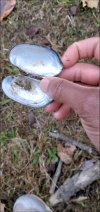DoubleD1996!
Well-Known Member
There's this great spot I go to filled with mud and musk turtles cohabitating. There are tons of clams. They eat the smaller ones, but the muskrat, coons, and mink eat the larger ones. I want to breed some to have of my own. I know you have to dig for them and they're filter feeders, but is there any way to trap them? (If not, I shall invent one! I do not want to climb down there and dig).

